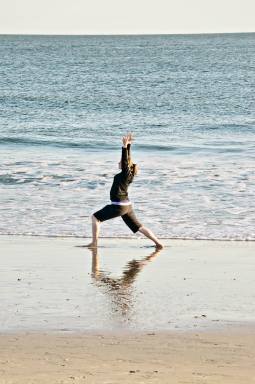I’ve been collecting links for a while, so here’s a link round-up!
- Mother and 4-Year-Old Daughter Take Impressive Pictures Of Their Yoga Poses: I linked this in a recent post about practicing yoga with YB, but I just can’t get over this. It makes me a little teary, actually. I love these photos: I love the joyful looks on their faces, I love the little girl’s obvious commitment to each pose, I love their matching pants. I would love to do a photo shoot like this with my YB someday, but clearly I need to step up my game because there are some arm balances here that I just can’t pull off. 🙂
- A Selection from the Hammer Museum at UCLA’s Contemporary Collection: Katie Grinnan’s Mirage: To create this fascinating sculpture, Grinnan “cast multiple molds of her body executing a sun salutation”. I find the piece exhilarating, exciting, and also a little creepy.
- The Strength-Building Yoga Pose That Tons of People Do Wrong: Related to sun salutations, I love this informative video from superstar yogini Kathryn Budig on how to chaturanga properly without hurting yourself.
- Bending the Rules to Offer Yoga With a Beer Chaser: My father-in-law sent me the link to this NYT article about yoga classes in breweries, offering a beer tasting after class. While I love both yoga and craft beer, I’m really not sure how I feel about this. I find that yoga, like running or dancing or working out, makes me feel fresh and healthy and connected to my body; afterwards I typically want a glass of water, a banana, a salad, a smoothie. I just don’t feel like beer would taste right after a yoga practice – but believe me, I’d try it! And I think it’s fantastic that classes like this are leading people to yoga and helping them build a practice that can extend beyond the brewery.
- Yoga Every Damn Day: My husband sent me the link to this piece about how, when we’re dealing with other issues in our lives and can’t make it to the yoga mat, we’re still practicing yoga every damn day. I don’t know Angela Arnett but I admire her strength and calm in this piece.
- Pope Francis Reveals Secrets of Happiness: Can I tell you how much I love Pope Francis? He seems to be so full of kindness and peace, focused on loving and helping and supporting people. Everything he lists here is also discussed by Matthieu Ricard, former scientist and Buddhist monk, in his book Happiness, and seems to be in agreement with everything I’ve ever heard or read from the Dalai Lama, including the concepts discussed in The Art of Happiness. When the Catholic Pope and the Dalai Lama agree about how you should live your life, I feel like there’s something right happening.
- And finally, for your giggle for the day: Men in Yoga Pants.













